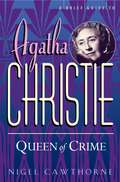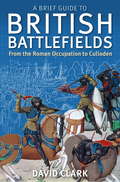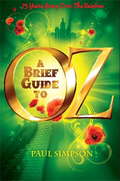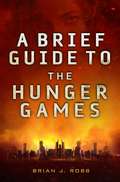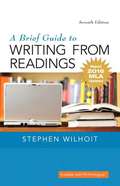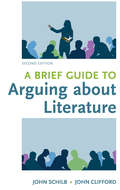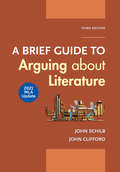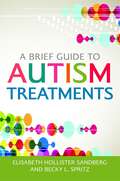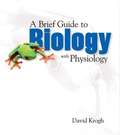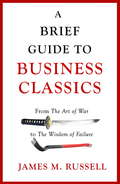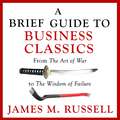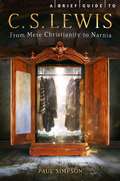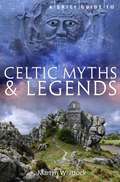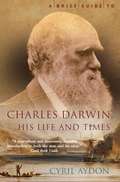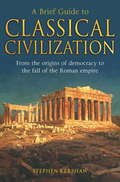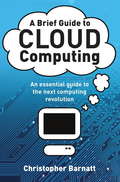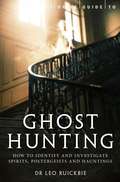- Table View
- List View
A Brief Guide To Agatha Christie (Brief Histories)
by Nigel CawthorneAgatha Christie’s 80 novels and short-story collections have sold over 2 billion copies in more than 45 languages, more than any other author. When Christie finally killed off her Belgian detective, Hercule Poirot, the year before she herself died, that ‘detestable, bombastic, tiresome, ego-centric little creep’ in Christie’s words, received a full-page obituary in the New York Times, the only fictional character ever to have done so. From her first novel, The Mysterious Affair at Styles, a Poirot mystery, to her last, Sleeping Murder, featuring Miss Marple, Crawford explores Christie’s life and fiction. Cawthorne examines recurring characters, such as Captain Arthur Hastings, Poirot’s Dr Watson; Chief Inspector Japp, his Lestrade, as well as other flat-footed policemen that Poirot outsmarts on his travels; his efficient secretary, Miss Felicity Lemon; another employee, George; and Ariadne Oliver, a humorous caricature of Christie herself. He looks at the writer’s own fascinating: her work as a nurse during the First World War; her strange disappearance after her first husband asked for a divorce; and her exotic expeditions with her second husband, the archaeologist Sir Max Mallowan. He examines the author’s working life – her inspirations, methods and oeuvre – and provides biographies of her key characters, their attire, habits and methods, including Poirot’s relationships with women, particularly Countess Vera Rossakoff and Miss Amy Carnaby. In doing so, he sheds light on the genteel world of the country house and the Grand Tour between the wars. He takes a look at the numerous adaptations of Christie’s stories for stage and screen, especially Poirot’s new life in the eponymous long-running and very successful TV series.
A Brief Guide To British Battlefields: From the Roman Occupation to Culloden
by David ClarkA very readable work of reference offering a survey in chronological order, from AD 84 to 1746, of the major battles which have taken place on British soil, from the Roman occupation to Culloden, the last battle fought on British soil. In this way, the book can be read as a continuous narrative, while each entry also stands alone as a self-contained guide. The battles are grouped into relevant sections (such as the Wars of the Roses, the English Civil Wars and the Jacobite Rebellions), within broader historical periods. Each period is prefaced by a presentation of the nature of warfare and is enhanced by a feature article of specialist interest. Every entry includes a narrative of events leading up to the battle, a vivid description of the battle itself and an assessment of the long and short-term, consequences. In addition, there is useful information for visits, including precise identification of the location, details of access to and features of each site. The book is illustrated throughout with maps and a plate section.
A Brief Guide To British Battlefields: From the Roman Occupation to Culloden (Brief Histories)
by David ClarkA very readable work of reference offering a survey in chronological order, from AD 84 to 1746, of the major battles which have taken place on British soil, from the Roman occupation to Culloden, the last battle fought on British soil. In this way, the book can be read as a continuous narrative, while each entry also stands alone as a self-contained guide. The battles are grouped into relevant sections (such as the Wars of the Roses, the English Civil Wars and the Jacobite Rebellions), within broader historical periods. Each period is prefaced by a presentation of the nature of warfare and is enhanced by a feature article of specialist interest. Every entry includes a narrative of events leading up to the battle, a vivid description of the battle itself and an assessment of the long and short-term, consequences. In addition, there is useful information for visits, including precise identification of the location, details of access to and features of each site. The book is illustrated throughout with maps and a plate section.
A Brief Guide To OZ: 75 Years Going Over The Rainbow (Brief Histories)
by Paul SimpsonWhat if Dorothy Gale wasn't the only person who went to see the Wizard of Oz? MGM's landmark 1939 movie The Wizard of Oz, starring Judy Garland, did not mark the beginning of adventures in Oz. Both before and since, dozens of tales have been told of the Marvellous Land of Oz, and its inhabitants such as the Scarecrow, the Tin Woodman, the Cowardly Lion, the Hungry Tiger and Jack Pumpkinhead. In this fascinating and wide-ranging book, Paul Simpson looks back at the Famous Forty - the original novels by L. Frank Baum and his successors which entranced generations of children with their wonderful world of munchkins, princesses and wicked witches. He examines the many ways in which the stories have been retold in movies - from the silent era to Disney's recent blockbuster Oz the Great and Powerful - and on television, featuring everyone from Tom & Jerry to trades union leaders. On stage, Oz has come to life in the many revivals of The Wizard of Oz musical and the worldwide reign of Elphaba in the smash hit Wicked. Celebrate the 75th anniversary of the world's best-loved film and the whole magical world of Oz with its vampires, muppets, dragons, living statues and so much more.
A Brief Guide To OZ: 75 Years Going Over The Rainbow
by Paul SimpsonWhat if Dorothy Gale wasn't the only person who went to see the Wizard of Oz? MGM's landmark 1939 movie The Wizard of Oz, starring Judy Garland, did not mark the beginning of adventures in Oz. Both before and since, dozens of tales have been told of the Marvellous Land of Oz, and its inhabitants such as the Scarecrow, the Tin Woodman, the Cowardly Lion, the Hungry Tiger and Jack Pumpkinhead. In this fascinating and wide-ranging book, Paul Simpson looks back at the Famous Forty - the original novels by L. Frank Baum and his successors which entranced generations of children with their wonderful world of munchkins, princesses and wicked witches. He examines the many ways in which the stories have been retold in movies - from the silent era to Disney's recent blockbuster Oz the Great and Powerful - and on television, featuring everyone from Tom & Jerry to trades union leaders. On stage, Oz has come to life in the many revivals of The Wizard of Oz musical and the worldwide reign of Elphaba in the smash hit Wicked. Celebrate the 75th anniversary of the world's best-loved film and the whole magical world of Oz with its vampires, muppets, dragons, living statues and so much more.
A Brief Guide To The Hunger Games (Brief Histories )
by Brian J. RobbA comprehensive and compelling guide to Suzanne Collins's bestselling young-adult, dystopian trilogy The Hunger Games, Catching Fire and Mockingjay.<P><P> Robb explores themes in The Hunger Games, and the influences and inspirations that lie behind the books, highlighting where Suzanne Collins has drawn on mythology and history, reshaping them to fit her universe. He examines the characters and situations created in the book and how these have impacted on the books' largely teen readership. He also looks at reactions to the books from fans and critics, both acclaim and criticisms faced by the author. <P>Robb chronicles the adaptation of The Hunger Games from acclaimed, best-selling novel to blockbusting film.
A Brief Guide To The Hunger Games (Brief Histories)
by Brian RobbA comprehensive and compelling guide to Suzanne Collins's bestselling young-adult, dystopian trilogy The Hunger Games, Catching Fire and Mockingjay. Already a publishing phenomenon to rival Harry Potter (over 50 million copies sold), the four blockbuster movies starring Jennifer Lawrence have grossed almost $3 billion dollars at the box office. Suzanne Collins has created a series of characters and situations that have struck a chord not only with the target audience of teenagers, but which have also drawn in adult readers: the series is second only to Harry Potter in NPR's popular poll of the Top 100 Teen Novels.Robb explores themes in The Hunger Games, and the influences and inspirations that lie behind the books, highlighting where Suzanne Collins has drawn on mythology and history, reshaping them to fit her universe. He examines the characters and situations created in the book and how these have impacted on the books' largely teen readership. He also looks at reactions to the books from fans and critics, both acclaim and criticisms faced by the author. Robb chronicles the adaptation of The Hunger Games from acclaimed, best-selling novel to blockbusting film. With a script by Suzanne Collins herself, the film has made stars of Jennifer Lawrence as Collins' heroine Katniss Everdeen, Josh Hutcherson as Peeta Mellark and Liam Hemsworth as Gale Hawthorne.
A Brief Guide To Writing From Readings
by Stephen WilhoitA Brief Guide to Writing from Readings is a clear, process-oriented guide to academic writing. The guide covers the subtleties of rhetorical analysis and argumentation strategies as well as the technical aspects of writing with sources. Students will learn first to examine texts critically and then to clearly, accurately and creatively respond in essay form. In-text tools including summary charts and revision checklists help students tackle source-based essays step by step. Instructors will rely on the guide as a one-stop reference tool; students can apply their learning to any discipline, whether for class work or independent study. <p><p> In the Seventh Edition, in response to student and faculty feedback, Wilhoit includes a new chapter on analyzing readings and composing analytical essays; more coverage of literary analysis and a new short story; eight academic readings; and expanded coverage of how to cite electronic sources in APA and MLA style.
A Brief Guide to Arguing about Literature
by John Schilb John CliffordMore and more, first- year writing courses foreground skills of critical analysis and argumentation. In response, A Brief Guide to Arguing about Literature first hones students' analytical skills through instruction in close critical reading of texts; then, it shows them how to turn their reading into well-supported and rhetorically effective argumentative writing. For instructors who prefer to aggregate their own anthology of readings and literary works for their literature-based composition courses, A Brief Guide to Arguing about Literature comprises only the writing-guide chapters of John Schilb and John Clifford's admired Arguing about Literature: Guide and Reader. In response to reviewer suggestions, this new edition of A Brief Guide to Arguing about Literature includes even more instruction in the key skills of argumentation, critical reading, and research than its predecessor.
A Brief Guide to Arguing about Literature with 2021 MLA Update
by John Schilb John CliffordThis ebook has been updated to provide you with the latest guidance on documenting sources in MLA style and follows the guidelines set forth in the MLA Handbook, 9th edition (April 2021).More and more, first-year writing courses foreground skills of critical analysis and argumentation. In response, A Brief Guide to Arguing about Literature first hones students’ analytical skills through instruction in close critical reading of texts; then, it shows them how to turn their reading into well-supported and rhetorically effective argumentative writing. For instructors who prefer to aggregate their own anthology of readings and literary works for their literature-based composition courses, A Brief Guide to Arguing about Literature comprises only the writing-guide chapters of John Schilb and John Clifford’s admired Arguing about Literature: Guide and Reader.
A Brief Guide to Autism Treatments
by Mary Beth Mccullough Becky L. Spritz Kirsten Brown Birtwell Susan E. Michelson Jill Myerow Bloom Kristen L. Batejan Joseph C. Viola Katherine K. Bedard Nicolas D. Taylor Elisabeth Hollister Sandberg Malorie L. DimlerThe number of intervention options available for children with autism can be overwhelming for parents. This book provides brief, user-friendly descriptions of the most commonly publicized treatments for autism, summarizing the available information in an objective and accessible way. Each short chapter covers a single treatment from Applied Behavior Analysis to Gluten-Free Casein-Free diets, as well as lesser known therapies such as Hyperbaric Oxygen Therapy. Each includes a definition and description; a summary of the prevailing information gleaned from popular press; an explanation of what the science says; and an idea of potential costs to parents and schools. This straight-talking and practical guide will allow parents of newly-diagnosed children, as well as any professionals working alongside them, to sift through the avalanche of advice and make their own informed choices about treatment.
A Brief Guide to Biology with Physiology
by David KroghThis book focuses on the core topics of biology with a friendly writing style and vivid illustrations while exploring current "real world" issues. A seven-part organization covers atoms, molecules, and cells; energy and life; genetics; evolution and the diversity of life; human anatomy and physiology; and plant anatomy and physiology. For anyone interested in increasing their biological literacy - enabling them to make informed decisions at the ballot box and understand the research findings they see in the news.
A Brief Guide to Business Classics: From The Art of War to The Wisdom of Failure
by James M. RussellThe world of business books is a curious place where one can find everyone from great businesspeople like Warren Buffett, Steve Jobs and Elon Musk, to the most spectacular business failures such as Enron and the sub-prime business market. There are geniuses, hard workers, academics and entrepreneurs as well a few charlatans and hucksters. There's even room for Donald Trump. The 70 titles covered were chosen with various parameters in mind: to cover a range of areas of business, from sales and marketing to negotiation, entrepreneurship to investing, leadership to innovation, and from traditional and corporate models of business to start-up manuals and alternative angles on the subject. Obvious bestselling titles such as How to Make Friends and Influence People or 7 Habits of Highly Effective People have been included, but there are also those books of more questionable value often included on recommended lists of business classics, included here by way of warning. The chosen books also cover a wide span of time and acknowledge that some of the most powerful or entertaining insights into business can be found in texts that aren't perceived as being 'business books', for instance The Art of War, Microserfs, Thinking Fast and Slow and The Wealth of Nations. The selection includes a good range of the most recent successes in business publishing with which readers may be less familiar. The titles are arranged chronologically, allowing the reader to dip in, but also casting an intriguing light on how trends in business titles have changed over the years. Among these titles, you will find expert advice, based on solid research (for instance The Effective Executive or Getting to Yes), and inspirational guides to setting up businesses and running them on sound foundations (such as True North, Crucial Conversations, or We) alongside dubious management manuals that take a single flawed idea and stretch it out to the point of absurdity. The hope is that the reader will be inspired to read the best of these titles, ignore the worst of them, and will come away with at least a basic idea of what each has to teach us about business.
A Brief Guide to Business Classics: From The Art of War to The Wisdom of Failure
by James M. RussellThe world of business books is a curious place where one can find everyone from great businesspeople like Warren Buffett, Steve Jobs and Elon Musk, to the most spectacular business failures such as Enron and the sub-prime business market. There are geniuses, hard workers, academics and entrepreneurs as well a few charlatans and hucksters. There's even room for Donald Trump. The 70 titles covered were chosen with various parameters in mind: to cover a range of areas of business, from sales and marketing to negotiation, entrepreneurship to investing, leadership to innovation, and from traditional and corporate models of business to start-up manuals and alternative angles on the subject. Obvious bestselling titles such as How to Make Friends and Influence People or 7 Habits of Highly Effective People have been included, but there are also those books of more questionable value often included on recommended lists of business classics, included here by way of warning. The chosen books also cover a wide span of time and acknowledge that some of the most powerful or entertaining insights into business can be found in texts that aren't perceived as being 'business books', for instance The Art of War, Microserfs, Thinking Fast and Slow and The Wealth of Nations. The selection includes a good range of the most recent successes in business publishing with which readers may be less familiar. The titles are arranged chronologically, allowing the reader to dip in, but also casting an intriguing light on how trends in business titles have changed over the years. Among these titles, you will find expert advice, based on solid research (for instance The Effective Executive or Getting to Yes), and inspirational guides to setting up businesses and running them on sound foundations (such as True North, Crucial Conversations, or We) alongside dubious management manuals that take a single flawed idea and stretch it out to the point of absurdity. The hope is that the reader will be inspired to read the best of these titles, ignore the worst of them, and will come away with at least a basic idea of what each has to teach us about business.
A Brief Guide to C. S. Lewis: From Mere Christianity to Narnia
by Paul SimpsonNovember 2013 marks the 50th anniversary of the death of Clive Staples 'Jack' Lewis, when a memorial to him will be placed in Poet's Corner in Westminster Abbey. Although perhaps best known as the author of the seven Chronicles of Narnia, published between 1949 and 1954, Lewis also wrote The Pilgrim's Regress, a trilogy of science-fiction novels incorporating Christian themes, and a large number of non-fiction books about his faith, accessible to Christians and non-believers alike. In a survey of the greatest British writers since 1945, the Times newspaper ranked Lewis eleventh, ahead of Salman Rushdie, Anthony Burgess and Ian Fleming.A Brief Guide to C. S. Lewis explores Lewis's life, from his reconversion to Christianity under the influence of his friend J. R. R. Tolkien, which had such a profound influence on his writing - both fiction and non-fiction - to his marriage to American writer Joy Davidman Gresham and his battle with cancer. He died on 22 November 1963, a day before the first-ever episode of Dr Who, a TV series with many links to his Narnia stories was shown. Although this Brief Guide ranges well beyond the world of Narnia to explore other aspects of Lewis's life and his other writings, it does not do so - unusually among books on Lewis - from the point of view of Christian scholarship, thereby assuming much knowledge of theology on the part of readers. That Lewis wrote about the problems of praying is significant; the specific texts he discusses and dissects are likely to be of less significance to most readers.The guide provides synopses of Lewis's fiction, an overview of his other writings, a biography and a look at all the many different versions of his stories that have appeared. In doing so it draws on recent interviews by the author with some of the many talented people who have worked on these adaptations.
A Brief Guide to C. S. Lewis: From Mere Christianity to Narnia (Brief Histories)
by Paul SimpsonNovember 2013 marks the 50th anniversary of the death of Clive Staples 'Jack' Lewis, when a memorial to him will be placed in Poet's Corner in Westminster Abbey. Although perhaps best known as the author of the seven Chronicles of Narnia, published between 1949 and 1954, Lewis also wrote The Pilgrim's Regress, a trilogy of science-fiction novels incorporating Christian themes, and a large number of non-fiction books about his faith, accessible to Christians and non-believers alike. In a survey of the greatest British writers since 1945, the Times newspaper ranked Lewis eleventh, ahead of Salman Rushdie, Anthony Burgess and Ian Fleming.A Brief Guide to C. S. Lewis explores Lewis's life, from his reconversion to Christianity under the influence of his friend J. R. R. Tolkien, which had such a profound influence on his writing - both fiction and non-fiction - to his marriage to American writer Joy Davidman Gresham and his battle with cancer. He died on 22 November 1963, a day before the first-ever episode of Dr Who, a TV series with many links to his Narnia stories was shown. Although this Brief Guide ranges well beyond the world of Narnia to explore other aspects of Lewis's life and his other writings, it does not do so - unusually among books on Lewis - from the point of view of Christian scholarship, thereby assuming much knowledge of theology on the part of readers. That Lewis wrote about the problems of praying is significant; the specific texts he discusses and dissects are likely to be of less significance to most readers.The guide provides synopses of Lewis's fiction, an overview of his other writings, a biography and a look at all the many different versions of his stories that have appeared. In doing so it draws on recent interviews by the author with some of the many talented people who have worked on these adaptations.
A Brief Guide to Celtic Myths and Legends (Brief Histories )
by Martyn WhittockA very readable guide which fills the gap between academic analysis and less critical retellings of the myths and legends. Marytn Whittock provides an accessible overview while also assessing the current state of research regarding the origins and significance of the myths. Since all records of the myths first occur in the early medieval period, the focus is on the survival of pre-Christian mythology and the interactions of the early Christian writers with these myths. A wide-ranging and enthralling introduction to Celtic mythology, from the Irish gods before gods, the Fomorians, to the children of Llyr, the sea deity; from the hunter-warrior Fionn mac Cumhaill, whose exploits are chronicled in the Fenian Cycle, to Cú Chulainn, the Hound of Ulster; and from the Welsh heroes of the Mabinogion to Arthur, King of Britain, though the mythical, Welsh version who predates the medieval legends.
A Brief Guide to Celtic Myths and Legends (Brief Histories)
by Martyn WhittockA very readable guide which fills the gap between academic analysis and less critical retellings of the myths and legends. Marytn Whittock provides an accessible overview while also assessing the current state of research regarding the origins and significance of the myths. Since all records of the myths first occur in the early medieval period, the focus is on the survival of pre-Christian mythology and the interactions of the early Christian writers with these myths. A wide-ranging and enthralling introduction to Celtic mythology, from the Irish gods before gods, the Fomorians, to the children of Llyr, the sea deity; from the hunter-warrior Fionn mac Cumhaill, whose exploits are chronicled in the Fenian Cycle, to Cú Chulainn, the Hound of Ulster; and from the Welsh heroes of the Mabinogion to Arthur, King of Britain, though the mythical, Welsh version who predates the medieval legends.
A Brief Guide to Charles Darwin
by Cyril AydonCharles Darwin has become one of the most important men in history. The quiet, unsure polymath who avoided confrontation, ensconced in his family home at Down House in Kent, was also a revolutionary who developed his idea of Natural Selection in isolation. Cyril Aydon's short biography is considered one of the best introductions to the life and ideas of Darwin.With Darwin's legacy still in contention and the forthcoming anniversary of the publication of The Origins Species, Aydon's book is a perfect guide to the ideas as well as the man who was recently voted one of the greatest Britons of all time, and certainly one of the most influential thinkers ever.
A Brief Guide to Charles Darwin (Brief Histories)
by Cyril AydonCharles Darwin has become one of the most important men in history. The quiet, unsure polymath who avoided confrontation, ensconced in his family home at Down House in Kent, was also a revolutionary who developed his idea of Natural Selection in isolation. Cyril Aydon's short biography is considered one of the best introductions to the life and ideas of Darwin.With Darwin's legacy still in contention and the forthcoming anniversary of the publication of The Origins Species, Aydon's book is a perfect guide to the ideas as well as the man who was recently voted one of the greatest Britons of all time, and certainly one of the most influential thinkers ever.
A Brief Guide to Classical Civilization (Brief Histories)
by Dr Stephen P. KershawA general introduction to the classical world from its origins to the fall of the Roman Empire. The book focuses on questions of how we know about Classical civilization from archaeology and history; deals with the Mycenaean era and the world of Myth and Epic in Homer's Iliad & Odyssey; gives an outline of Greek history in the 5th & 4th Centuries BC; looks at Greek social life and the alternative model of Sparta, and considers the achievements of the Greeks in their art and architecture, tragedy and comedy. Turning to Rome, it engages with Roman history, the Roman Epic tradition, the fascinating features of Roman social life, analyses Roman satire, explores the urban environment in Pompeii and Herculaneum, and concludes with the End of Rome.
A Brief Guide to Classical Civilization (Brief History Ser.)
by Stephen P. KershawA general introduction to the classical world from its origins to the fall of the Roman Empire. The book focuses on questions of how we know about Classical civilization from archaeology and history; deals with the Mycenaean era and the world of Myth and Epic in Homer's Iliad & Odyssey; gives an outline of Greek history in the 5th & 4th Centuries BC; looks at Greek social life and the alternative model of Sparta, and considers the achievements of the Greeks in their art and architecture, tragedy and comedy. Turning to Rome, it engages with Roman history, the Roman Epic tradition, the fascinating features of Roman social life, analyses Roman satire, explores the urban environment in Pompeii and Herculaneum, and concludes with the End of Rome.
A Brief Guide to Cloud Computing: An Essential Introduction To The Next Revolution In Computing
by Christopher BarnattAn accessible and comprehensive guide to the future of computing.Cloud Computing is the next computing revolution and will have as much impact on your life as the introduction of the PC. Using websites including Facebook, Flickr and Gmail, many people already store some information out in the Internet cloud. However, within a few years most computing applications will be accessed online with the web at the heart of everything we do.In this valuable guide, expert Christopher Barnatt explains how computing will rapidly become more reliable, less complex, and more environmentally friendly. He explores online software and hardware, and how it will alter our office work and personal lives. Individuals and companies are going to be released from the constraints of desktop computing and expensive corporate data centres. New services like augmented reality will also become available.Including coverage of Google Docs, Zoho, Microsoft Azure, Amazon EC2 and other key developments, this book is your essential guide to the cloud computing revolution.
A Brief Guide to Cloud Computing: An essential guide to the next computing revolution. (Brief Histories)
by Christopher BarnattAn accessible and comprehensive guide to the future of computing.Cloud Computing is the next computing revolution and will have as much impact on your life as the introduction of the PC. Using websites including Facebook, Flickr and Gmail, many people already store some information out in the Internet cloud. However, within a few years most computing applications will be accessed online with the web at the heart of everything we do.In this valuable guide, expert Christopher Barnatt explains how computing will rapidly become more reliable, less complex, and more environmentally friendly. He explores online software and hardware, and how it will alter our office work and personal lives. Individuals and companies are going to be released from the constraints of desktop computing and expensive corporate data centres. New services like augmented reality will also become available.Including coverage of Google Docs, Zoho, Microsoft Azure, Amazon EC2 and other key developments, this book is your essential guide to the cloud computing revolution.
A Brief Guide to Ghost Hunting: How To Identify And Investigate Spirits, Poltergeists And Hauntings (Brief Histories )
by Leo RuickbieThere has been an upsurge in books, television programmes, films and websites exploring the reality or otherwise of the spirit world. Not since the founding of The Ghost Club in 1862 and the Society for Psychical Research in 1882 has ghost hunting been so popular. Television and the internet, in particular, have fueled this new level of interest, creating a modern media phenomenon that spans the globe. But while the demand for information is high, good information remains scarce. A Brief Guide to Ghost Hunting leads us through the process of ghost hunting, from initially weighing the first report, to choosing equipment, and investigating and identifying the phenomena, with an analysis of the best places to go looking, methods of contacting the spirit world, how to explain paranormal activity and, crucially, how to survive the encounter. However, it is also a book about ghost hunting itself, drawing on 130 years of research in the cavernous archives of the Society for Psychical Research and even older history to find the earliest ghost stories. A Ghost Hunting Survey makes use of interviews with those billing themselves as ghost hunters to find out their views, motivations and experiences. New and original research makes use of statistics to map the nebulous world of apparitions while a Preliminary Survey of Hauntings offers an analysis of 923 reported phenomena from 263 locations across the UK.This is, as far as possible, an objective presentation of ghosts and ghost hunting. It is no wonder that mainstream science largely refuses to deal with the subject: it is too complicated. Without trying to convince you of any viewpoint, this book is intended to help you understand more.
